
Syrphus ribesii is a very common Holarctic species of hoverfly. Its larvae feed on aphids. In common with many other species of hoverfly, males have the eyes meeting on the top of the head, whilst females have their eyes widely separated.

Xylota segnis, The Brown-toed Forest Fly, is a common species of hoverfly.
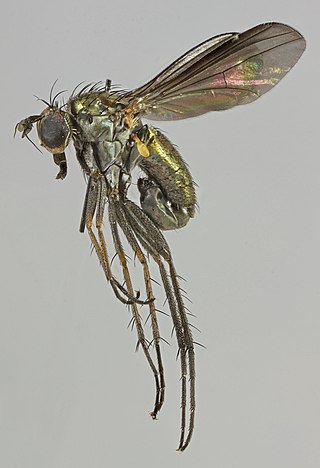
Hercostomus is a genus of flies in the family Dolichopodidae. It is a large genus, containing more than 483 species worldwide. Multiple studies have shown that Hercostomus is a polyphyletic assemblage of species.
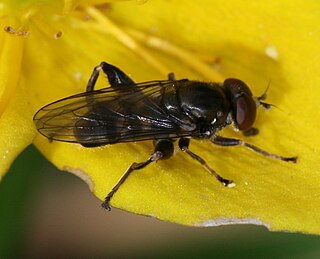
Chalcosyrphus (Xylotomima) nemorum , the Dusky-banded Leafwalker, is a common species of syrphid fly with a Palearctic and Nearctic distribution. Hoverflies get their names from the ability to remain nearly motionless while in flight. The adults are also known as flower flies for they are commonly found around and on flowers, from which they get both energy-giving nectar and protein-rich pollen. Larvae have been found under the bark of Larix, Pinus and a variety of hardwoods.
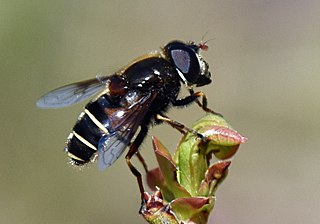
Eristalis cryptarum is a holarctic species of hoverfly. Known as the bog hoverfly or bog-dwelling drone fly, it is a bog specialist but may occur in other wetlands. Its larvae are assumed to live in peat that is saturated with water, such as that found in these boggy areas. The female has been observed depositing eggs on and close to very fresh cow dung along oligotrophic seepages in moorland.

Syrphus vitripennis is a very common European and North American species of hoverfly. Its larvae feed on aphids
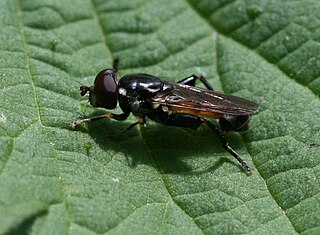
Tropidia scita is a common Palearctic species of hoverfly associated with wetlands, ponds and ditches. The larvae have been recorded living in the basal sheaths of Typha.

Paragus haemorrhous,the Black-backed Grass Skimmer is a common widespread species of hoverfly found in many parts of Europe, Africa and the Nearctic. Hoverflies can remain nearly motionless in flight. The adults are also known as flower flies for they are commonly found on flowers from which they get both energy-giving nectar and protein-rich pollen. The larvae are predators on aphids.

Psila fimetaria is a species of fly, a member of the family Psilidae.

Xylota florum is a Palearctic species of hoverfly.

Campiglossa loewiana is a species of fly in the family Tephritidae, the gall flies. The species is found in the Palearctic. The body is black brown; the upper part of pleuras and the midline of the scutellum dirty yellow. Femora 1 and III more or less browned.Oviscapte is a shiny black.Long. : 3-4 mm. The larvae feed in flower heads of Solidago virgaurea and Aster amellus.

Lonchaea chorea is a species of fly in the family Lonchaeidae. It is found in the Palearctic. The larva develops in cow dung.

Agromyza nigripes is a species of fly in the family Agromyzidae. It is found in the Palearctic. The body is black. The thorax and abdomen are shiny. There are 1 + 4 dorsocentral bristles and 7 rows of acrostical bristles. The wing veins are brown, yellow at the base. Long. : 2–3,5 mm. The larva makes serpentine mines in Medicago sativa leaves.
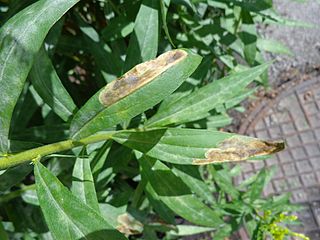
Nemorimyza posticata is a species of fly in the family Agromyzidae. It is found in the Palearctic.
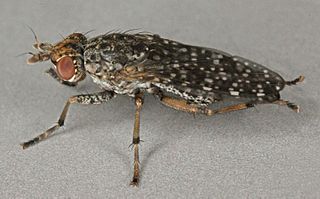
Dictya umbrarum is a species of fly in the family Sciomyzidae. It is found in the Palearctic and Nearctic. Long. : 4-5 mm. Intensely spotted wings.The interocular space with a black mark at the anterior orbital.The face is white with a black or brown central point. The antennae are reddish, the arista yellow at the base.The body is black covered in a grey yellow pruinosity with shifting (changeant) brown spots on the abdomen.The femora are grey with a brown apical band.The tibia are yellow with a brown apical ring (anneau). For terms see Morphology of Diptera. Dictya montana is a predator of aquatic pulmonate snails with no apparent parasitoid tendency.

Elgiva cucularia is a species of fly in the family Sciomyzidae. It is found in the Palearctic .Long. : 5-8 mm.Overall it is coloured yellowish-brown with a bluish-gray body. The head is characterized by silky black dots at the bases of the anterior orbital setae, between the bases of the antennae and the edges of the compound eyes, and in the centre of the occiput. The third antenna segment is a little shorter than the second. The mesonotum is black with a grey ground and grey pruinosity.There are longitudinal, brown stripes on the dorsum of the thorax: two narrow in the middle and two wide on the sides. One mesopleural bristle amongst short setae.The prothorax is bare. The yellowish smoky wings are 5.2 to 6.8 mm long and have fuzzy spots on the front half. The legs and abdomen are yellow. The lower surfaces of the hind femora are equipped with setae, while the front pair lacks them.The abdomen is rufous.For terms see Morphology of Diptera. Larvae of E. cucularia are predators of aquatic, pulmonate snails in the families Lymnaeidae, Physidae, and Planorbidae.
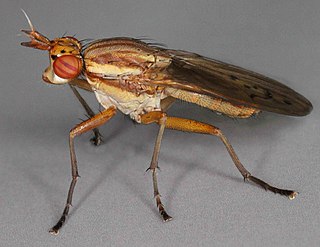
Ilione albiseta is a species of fly in the family Sciomyzidae. It is found in the Palearctic .The body length is 8 to 11.2mm and the basic colour is yellowish-brown. The spot on the occiput, the spots at the base of the frontal orbital setae and the almost triangular spots at the edge of the eyes at the height of the antennae are silky dark brown. The long antennae have a whitish hairy arists. There are longitudinal, brown stripes on the yellowish-dustedmesonotum : two narrow in the middle and two wide on the sides. In addition, there is a brown band on the body below the notopleura. The prosternum is bare. Chaetotaxy of the thorax shows strong presutural acrostichal setae and 2–3 well-developed subalar setae. The wings are 6.8 to 8 mm long and usually have 5 marks: on the anterior transverse vein, the medial vein, and the two ends of the posterior transverse vein. If there are only 2 dots on the medial vein, the transverse veins are at least darkened. The legs are yellow with darkened tarsi. The lower surfaces of the femora of the hind legs are equipped with strong and dense setae in males, and with short and sparse setae in females. Males are characterized by a copulatory apparatus with non-swollen abdominal pituitary glands.For terms see Morphology of Diptera. The larva preys on Galba truncatula
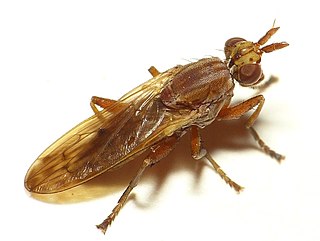
Elgiva solicita is a species of fly in the family Sciomyzidae. It is found in the Palearctic
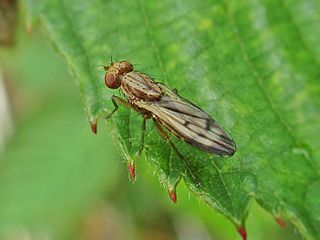
Opomyza petrei is a species of fly in the family Opomyzidae. It is found in the Palearctic.
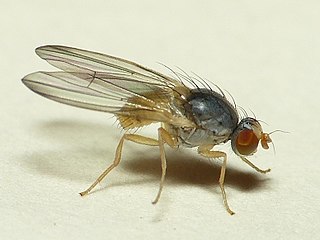
Palloptera ustulata is a species of fly in the family Pallopteridae. It is found in the Palearctic The wings are diffusely shaded brown with a darker tip. The back of the head is largely black.The face and antennae are yellow.The thorax is black with a fairly long whitish pilosity .The legs,tarsi and halteres are yellowish.Long. : 4 mm.The larvae develop under the bark of deciduous trees. It is part of a species complex and difficult to determine with certainty.




















